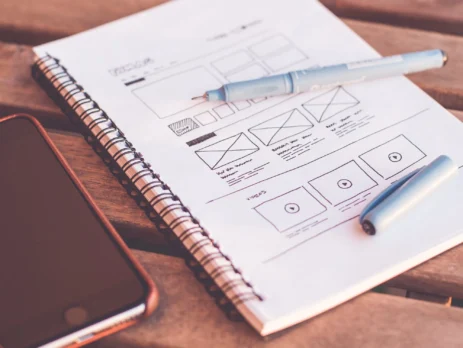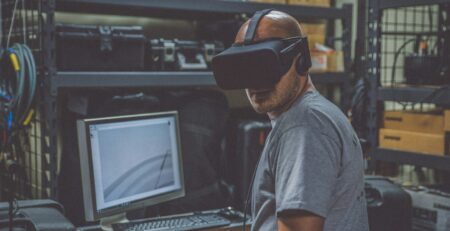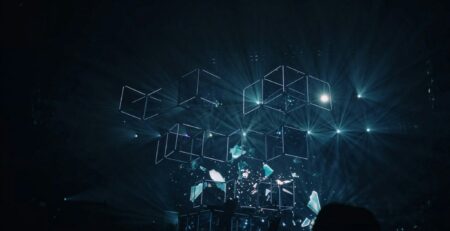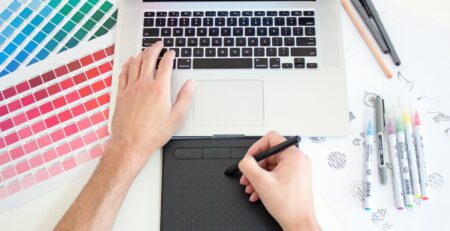Why AI Can’t Make UI and UX Designers Obsolete
As AI and automation continue advancing, it has left many people wondering about the future of various jobs and industries. One area of speculation is whether machines might eventually replace user experience designers. After all, if computers can be programmed to identify patterns and make suggestions, why would we still need people for that? If you’re a design professional wondering about your career’s longevity or simply curious about humanity’s place alongside intelligent machines – we’ll provide insights to help clear your worries.
Impact of AI On UI/UX Design
AI is having significant impacts across many industries, and UI/UX design is certainly no exception. Its impact on the field is immense and will only grow as these various AI applications become more advanced. Here are some of the key ways AI is influencing and will continue to influence UI/UX design:
AI-Assisted Workflow Tools
As AI continues advancing, we’re seeing more and more tools emerge that use its capabilities to enhance design workflows. Some might worry this means machines will replace human designers. But in reality, these so-called “AI assistants” are making lives much easier.
Take project management, for example. Coordinating timelines, assigning tasks, and keeping everyone on schedule can be a chore. But now AI tools can take over these administration tasks, so you spend your energy where it matters – on actual design work. AI prototypes also allow jumping straight to visualization, speeding up iterations during prototyping. You just feed it what you want and get fully clickable screens at your fingertips.
Generative Design Tools
The new generative design tools have become super helpful partners in the design process. They work by learning from many existing designs and finding common patterns and components. Then, based on what you tell them, like the use case or style preferences, they blend all the reference material together to cook up novel concepts swiftly.
No more blank-slate paralysis when you’re starting from scratch. Just give it a simple prompt, and instantly, you’ll have lots of inspired starting points to consider. And it’s not just visuals, as you can generate complete flows, motion concepts, and even copy suggestions to jumpstart creativity.
Automated Testing
Testing interfaces used to be such a pain. But now, so many tools use AI to automate for you. These programs can not only simulate tons of users quicker than humans but actually learn from their interactions, too. So they get smarter about where issues often arise. Then, they surface problems in real time, right down to things you might miss.
For example, a tool can record automated users clicking around. Then, it analyzes whether tasks were completed successfully or where clicks went awry. So, you don’t need moderated studies, as it collects anonymous usage data constantly. These bots speed up what was once manual labor with the same principles of testing usability, just way faster turnaround.
Automated Routine Tasks
As a designer, there are just some tasks that feel like such a chore every time. Things that you’ve done a million times before but still eat up valuable time. Well, AI can automate some of that grunt work.
Making icons or basic assets used to be tedious when clicking away in Illustrator or Photoshop. But now, certain programs do it for you based on a simple text input or style guide. It’s the same thing for initial mockups or page templates. Having a robot knock those out from a template saves hours versus building by hand each iteration.
Automation also makes file prep and handoffs a breeze. Rather than formatting visuals for each tool and platform, you can have it all automated now, no matter the recipient.
Enhanced Design Research
AI is helping to streamline design research in smart ways. For one, tools can automate recruiting globally and run remote discussions at a massive scale. It saves tons of legwork finding test participants wherever they are. They can also transcribe interviews flawlessly and analyze open responses for patterns or sentiments in huge qualitative datasets. This saves hours of manual coding.
AI can also spot correlations we’d never notice, like how certain answers relate to demos, or it can cluster users visually based on behaviors. This helps to reveal nuances to drive better solutions.
Personalized Experiences
AI is impacting design by enabling highly personalized experiences. In the past, websites and apps tended to have a “one size fits all” approach. But with massive datasets and machine learning models, AI allows interfaces to be tailored specifically to individual users.
AI systems can analyze online behavior, demographic information, purchase history, and more to develop a sophisticated understanding of a person’s interests, preferences, and typical workflows. This data is then used behind the scenes to deliver a unique, optimized experience for each user. For example, some websites will customize menu options, recommendations, or default settings based on what the AI predicts a user will most likely need based on their profile.
Why AI Can’t Replace UI/UX Designers

While AI systems have immense capabilities, there are still some clear limitations when it comes to replicating the full range of skills, qualities, and responsibilities required of UX designers. Let’s look at some key reasons why AI is unlikely to fully replace human UX professionals soon.
Limitations in Evaluating Design Quality
Judging what makes for truly great design is subjective in many ways. And assessing quality isn’t just about usability stats or style guides-there’s an art to it. That’s one area that AI isn’t yet equipped to handle on its own. There’s so much refinement in what resonates with people or feels innovative.
Design quality is about so much more than just numbers and guidelines. Sure, AI is great at analyzing metrics and patterns to spot usability issues. But where the magic really happens is in the less tangible realm of emotion, aesthetics, and that je ne sais quoi that makes an experience resonate deep down on a feeling level.
Not to mention, good design often breaks conventions for the right reasons. But teaching a computer when to color outside the lines versus when classic ideas should be applied is a kind of intuition that is amazingly complex.
Creativity
When you really get down to it, one of the things that sets human designers apart is our creativity. AI these days can generate some pretty cool ideas through machine learning patterns. But there’s still something special about the human capacity for creative imagination that algorithms alone can’t replicate.
Designers have this innate ability to look at problems in fresh, unexpected ways – to connect dots in our brains in new combinations. It’s how we develop solutions that feel genius, but perhaps an AI wouldn’t think of on its own. Machines are logical, but they don’t dream and visualize possibilities like humans do.
Human-Centered Design
User experience design has always been and will probably always be centered around people. After all, the whole goal is to craft great solutions that meet real human needs. But that’s something AI can’t get a total natural grasp of, no matter how advanced it gets.
Sure, algorithms can analyze reams of behavioral data and simulate users through personas. But there’s really no substitute for good old-fashioned human-to-human research and empathy that helps you truly understand what makes people tick, how they think and feel. Machines don’t have that innate ability to connect with what motivates people.
Ethical Concerns
The more AI progresses, the more growing concerns it raises regarding ethics. We all know algorithms can reflect the biases of their human creators, whether intentional or not. And that’s a real problem if it ends up excluding groups unintentionally. After all, design is supposed to serve everyone equally.
Privacy is another big area where more human input is still needed when AI is involved. As algorithms collect and share more of our personal info all the time, it raises some tricky challenges. Like figuring out what data is essential to share versus just excessive, making sure people truly understand and consent to what’s being done with their stuff, and enforcing security for people’s sensitive info.
Emotional Intelligence
One thing that separates human designers from machines is emotional IQ. Humans have this natural ability to understand how people feel on a deeper level in a way computers can’t replicate yet. We can grasp the distinctions behind what motivates folks and their real needs beyond surface-level tasks.
Empathy is such a core part of UX work. Those skills are used to genuinely connect with users during research so they can be really represented throughout the process. Our high emotional IQ lets us forge trusting relationships with communities and grasp full contexts that technology alone misses.
The Future of AI in UI/UX Design
While AI cannot fully replace human designers, its integration into the design process holds much promise for enhancing efficiency and insights. Here are some exciting possibilities for the use of AI in UI/UX design:

Streamlined Decision-Making Process
One way AI can be really useful for UX work going forward is by helping to optimize our processes for decision-making. Now, sorting through all the research, options, alternatives, and trade-offs to pick a solution can take a lot of time. But computers could streamline things in innovative ways down the road.
For example, AI could autonomously synthesize all our initial findings into concise, visually-driven reports to save us hours of manual work. That would buy our creative juices more time to focus higher.
Conversational UX
As machines improve natural language processing and contextual understanding, some nice possibilities are opening up for more conversational UX experiences. Instead of clunky menus, imagine interacting with an interface like you would a helpful friend.
Voice assistants and chatbots are already proving how much more intuitive they can make certain tasks so that soon, we may simply talk through our needs naturally. This would be really good for accessibility, too.
Conversational UX also enables more personalized interactions. With contextual awareness, interfaces become dynamic and can adjust in real time to better understand individual users. They can clarify ambiguities seamlessly to make for much smoother experiences.
Improved Assistance
In the future, AI could become our new assistant rather than a replacement in the design process. As machines continue learning, there’s huge potential for “augmented intelligence” to enhance our work through supportive collaboration.
For example, imagine if AI helpers could autonomously handle paperwork and initial research to give us mental space to focus on solving problems creatively. Computer programs getting smarter at making useful suggestions based on our work could also boost productivity and catch issues early as long as people carefully review them to avoid unfair biases.
Customized Experiences
AI can help us design even more personalized experiences for users. As systems gain a richer understanding of users through conversational data and preferences, they’ll better grasp what truly resonates with individuals.
Of course, privacy would need to be protected strictly so this information isn’t misused. But with consent and control, users might appreciate some personalization. Someone in a wheelchair, for example, would appreciate improved accessibility through customized design adjusted to their needs. By blending human oversight of values with AI’s personalization powers, we can develop experiences connecting with users on a deeper, more meaningful level.
Intelligent Automation
As AI gets smarter, it could take over more repetitive tasks, so we have time for creative work. AI could sketch basic designs privately using patterns, not private info. It may also find potential problems like things not working for some groups.
However, automated systems can reflect their creators’ biases, so they must be checked regularly. And closely guarding user data powering these tools is non-negotiable. Overall, smart bots could be designed to intelligently enhance human designers in secure, beneficial ways. As long as bots are upfront about limitations and humans are in charge, this type of automation could strengthen the process.
UI/UX Designers Are Here to Stay
While AI is getting wildly advanced at crunching data and automating tasks, there’s still no replacing the human touch in this line of work. Designing great experiences is as much an art as a science; it requires understanding real people, not just processing statistics. And who better than us empathetic humans to craft solutions that truly resonate?
There are some things computers just can’t replace – and design is one of them. UI/UX designers have nothing to fear for the future!
As a leading creative staffing agency, icreatives recognizes that as technology evolves, the need for talented human-centered designers will only increase. By providing access to top design talent, we ensure companies have the full toolkit to deliver intuitive, people-focused digital experiences. Call us at (+1) 855.427.3284 to get started.












